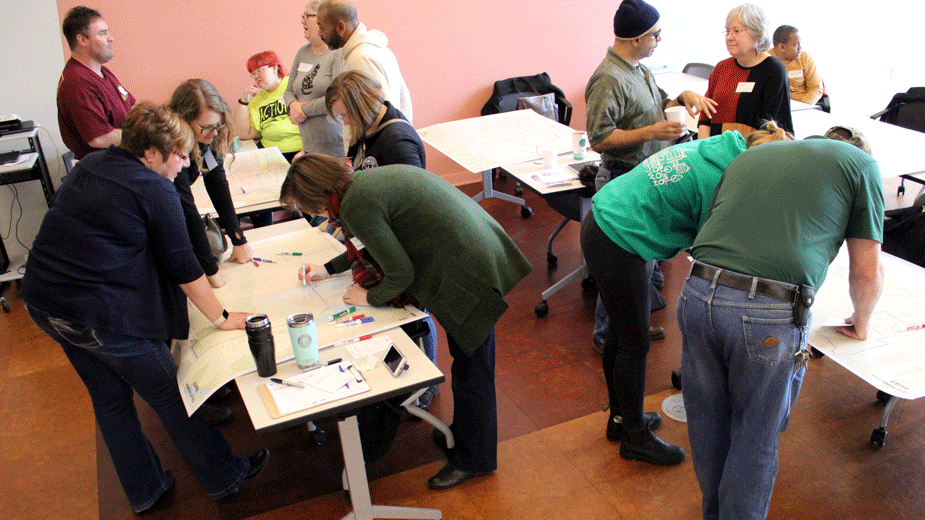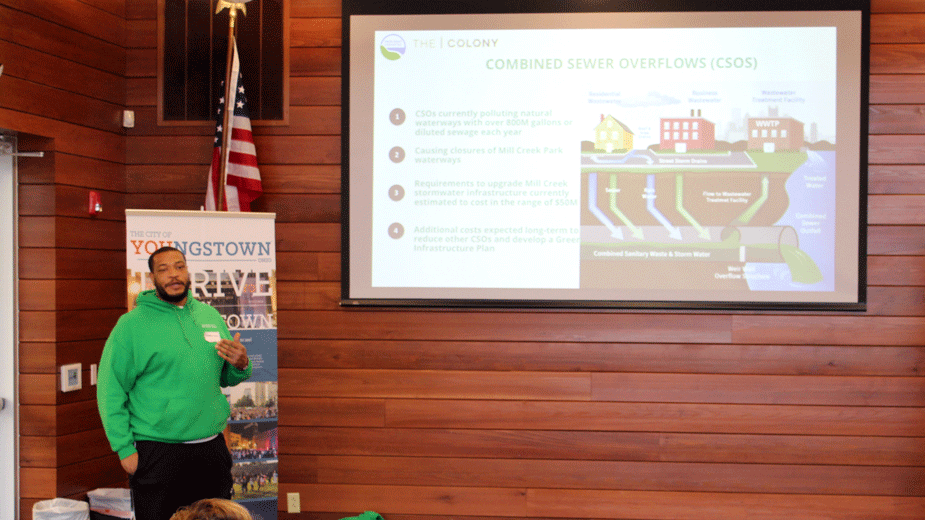Green Infrastructure Workshops Aim to Tackle City Flooding
YOUNGSTOWN, Ohio – The blight facing many parts of Youngstown has a silver lining. As part of revitalization, namely tearing down long-vacant houses, communities can address two issues at once: get rid of blighted properties and deal with flooding.
“Vacant lots are key and we have a lot of vacant lots here in the Valley,” said Keland Logan of The Colony Youngstown, a community improvement group. “Blight is an issue and green infrastructure is a solution. It solves the issue and provides aesthetic value.”
Logan led workshops across the city Thursday, Friday and Saturday about green infrastructure. The seminars were co-hosted by The Colony and Fresh Coast Communities.
When it comes to dealing with water, there are two forms of infrastructure. Gray infrastructure is what’s most commonly thought of: things like pipes, drains and basins. On the other end of the spectrum, Mendez explained, is green infrastructure, which uses natural growth, whether as a rain garden at home or green spaces with trees and plants separating sidewalks from roads.
“Youngstown, like many cities, has water infrastructure that was installed a hundred years ago,” she said, and as the city grew, systems were combined, leaving sewage and storm water to mix.
Normally, this isn’t an issue as all water heads through treatment before re-entering the water cycle. But when a big storm hits, the system can be overloaded with water, leaving that mixture to enter waterways.
“That excess water, which has raw sewage, automotive fluids and cigarette butts and dog waste, overflows into Mill Creek waterways and Mahoning River waterways,” she said.
The driving principle behind green infrastructure is that when it does rain – in any amount – the natural landscape acts as a drainage system, allowing water to soak into the ground while plants’ roots hold it all together.
But there are other benefits as well, Logan noted.
“Gray infrastructure goes into the ground. It’s extremely effective, it’s extremely costly and it doesn’t have any benefits other than solving capacity issues for the drainage system,” he said.
In neighborhoods with green infrastructure, crime rates are significantly lower and people are healthier. Planting 10 trees along a street, Mendez said, has a health impact similar to increasing income $10,000, as people are more likely to spend time outside and be active.
There are also impacts to local businesses, she continued.
“In terms of economic development, what we’ve seen in cities across the country – including places like Pittsburgh, Akron, Detroit and Gary, Ind. – is that when we’ve put in green infrastructure, shoppers are more likely to visit that area and they’re more likely to spend more money because they feel like they’re in a higher-end area,” she said.

As part of the workshop, participants were asked to mark on maps – one for each of the city’s wards – what areas are prone to flooding and places where they see criminal activity. The information and feedback from residents will be put into a report presented to City Council later this year.
Fresh Coast Communities and The Colony Youngstown are hosting 15 sessions – the first three were held Thursday, Friday and Saturday – through July. The first was hosted at Greater Friendship Missionary Baptist Church in conjunction with Four Square Block Watch.
“People identified flooding across every ward and they had ideas for very specific locations where green infrastructure could benefit,” said Laura Wood, a community and evaluation associate with Fresh Coast. “The community is looking for a voice. They have ideas and know what’s best. They know where the crime is, where the flooding is. They can see green infrastructure and how it can benefit the community.”
The city of Youngstown is required by the Environmental Protection Agency to reduce combined sewer overflows, which send millions of gallons of polluted water into area waterways. In 2015, the lakes in Mill Creek Park were closed to boating and fishing due to high levels of E. Coli after several strong rainstorms hit the area.
“The first step in this process should be educating people about what green infrastructure is and be able to make an educated decision,” Mendez said. “In order to make green infrastructure work for the city as a whole and especially for the neighborhoods, it needs to be informed by the residents.”
Pictured: Keland Logan of The Colony Youngstown discusses green infrastructure Friday at the Kusalaba Branch Library.
Copyright 2024 The Business Journal, Youngstown, Ohio.



